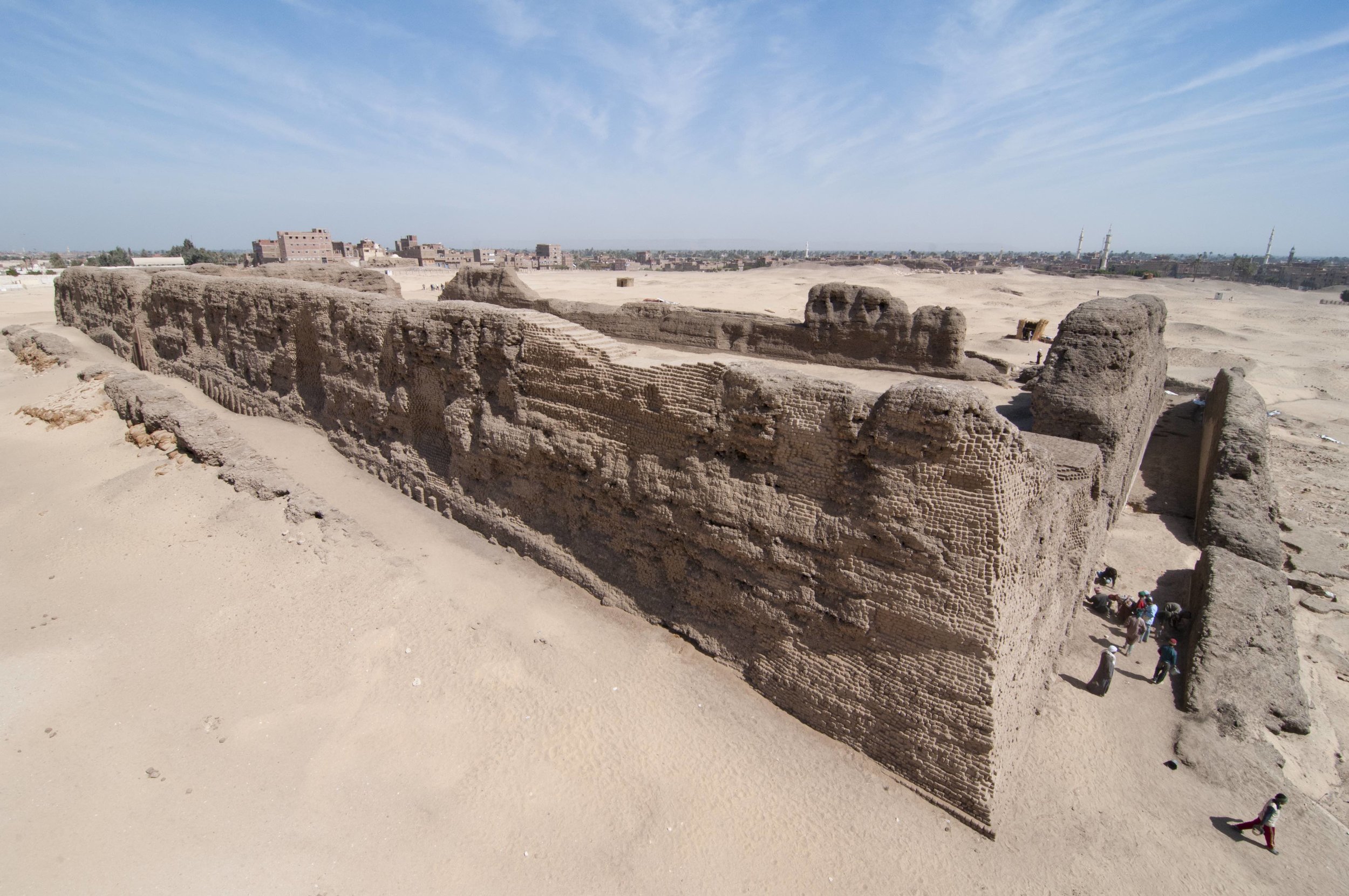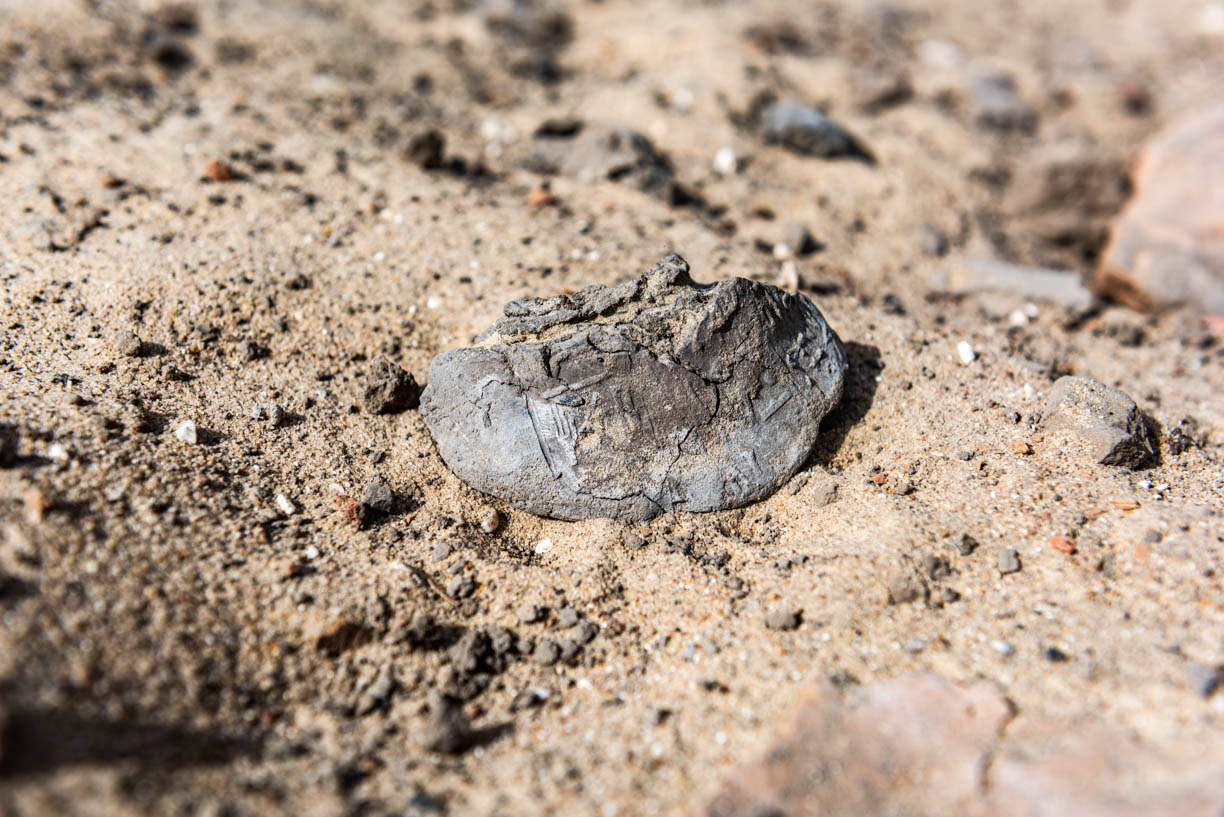Field Diary 2019.5 © Abydos Archaeology
Fig. 1. Seal impression dating to the reign of King Khasekhemwy (c. 2700 BCE) in situ. Photo by Ayman Damarany for North Abydos Expedition © 2019
Get it, impressive? As in 5,000-year-old seal impressions from the dawn of recorded history (Fig. 1).
As in the tantalizing shapes of someone’s ancient thoughts impressed in clay and buried for fifty centuries.
As in the power of those thoughts to reach out from the mists of time and impress us still in the age of the cloud.
One of the most exciting aspects of this season’s excavations in the Abydos North Cemetery was the discovery — under the talented supervision of archaeologist & Egyptologist Mohamed Abu el-Yazid (Fig. 2) — of a large number of Second Dynasty seal impressions from the reign of King Khasekhemwy (c. 2700 BCE), builder of the monumental cult enclosure known today as the Shunet el-Zebib. These seal impressions, found during the excavations outside the monument’s east corner gateway, undertaken in conjunction with the comprehensive documentation and architectural conservation program ongoing at the Shuneh, are evidence of the monument’s original purpose and ritual function in the early Egyptian state and society (Figs. 3,4).
Fig. 2. Archaeologist Mohamed Abu el-Yazid recording finds at the Abydos field house. Photo by Wendy Doyon for North Abydos Expedition © 2019
Fig. 3. Detail of Second Dynasty seal impressions excavated at the Shunet el-Zebib. Photo by Wendy Doyon for North Abydos Expedition © 2019
Fig. 4. Early morning excavation in progress outside the east corner gateway of the Shunet el-Zebib this season. Photo by Ayman Damarany for North Abydos Expedition © 2019
Fig. 5. View of the monumental Shunet el-Zebib on the desert landscape at Abydos. Photo by Greg Maka for North Abydos Expedition © 2012
Encountering the windswept remains of this curious, fortress-like building on the desert landscape today, it can be hard to imagine what, exactly, went on here five thousand years ago (Fig. 5). The Shuneh was, in fact, long mistaken for a fortress. But it is finds like these that help us to understand the history behind the legends.
Fig. 6. Remains of the original gateway in the northeast wall of the Shunet el-Zebib. Photo by Greg Maka for North Abydos Expedition © 2012
These broken pieces of clay sealings with hieroglyphic impressions were found right where someone dropped them on the floor, just outside the original, Second Dynasty door in the Shuneh’s northeast wall (Fig. 6). They are the material remains of human activity at the building during the reign of Khasekhemwy: the result of opening sealed containers, such as ceramic vessels, boxes, and bags, the contents of which were used as offerings in the rituals of the cult of the king, as well as the sealing and unsealing of a wooden door — in all probability THE door of the monument — while it was in active use around 2700 BCE. They also form part of a much larger body of evidence for ritual activity at the site over the course of King Khasekhemwy’s reign, which is discussed in a new article by Adams in the Abydos volume forthcoming this year from Peeters (more on that soon!).
Fig. 7. Seal impressions like this one, photographed in situ, are three-dimensionally complex objects that benefit greatly from new methods of archaeological documentation. Photo by Ayman Damarany for North Abydos Expedition © 2019
Their discovery this season, during the testing stage of our new 3D modeling program in the field, was especially exciting as it presented an opportunity to capture 3D data in real time as the seal impressions were brought to light on the excavations. Seal impressions, in particular, are three-dimensionally complex objects, difficult to document fully in 2D representations like drawings and photographs (Fig. 7). And because the real story of how they were used comes from the backside of the object, where impressions of what the sealings were applied to can be found, the chance to capture the 3D totality of each piece this season means that they can be very carefully analyzed by researchers in the future. Digital representations are also more easily disseminated than traditional forms of archaeological documentation, and an additional aim of our 3D modeling program is to create an online collection of excavated material from Abydos.
In the absence of a robust written record from the time of Egypt’s first kings, these broken bits and pieces of dried earth are some of the most precious clues we have for understanding the world as they knew it (Figs. 8-11). They are messages in the mud that have floated to us across a vast ocean of time. Now that’s impressive.
—Wendy Doyon, Matthew Douglas Adams, June 13, 2019
Fig. 8. Fragment of a seal impression in the artifact lab at the Abydos field house. Photo by Wendy Doyon for North Abydos Expedition © 2019
Fig. 10. Detail of seal impressions in process at the Abydos field house. Photo by Wendy Doyon for North Abydos Expedition © 2019
Fig. 9. Seal impressions are examined and processed for collections storage at Abydos. Photo by Wendy Doyon for North Abydos Expedition © 2019
Fig. 11. Archaeologists Mohamed Abu el-Yazid and Matthew Adams examine seal impressions in the lab. Photo by Wendy Doyon for North Abydos Expedition © 2019











